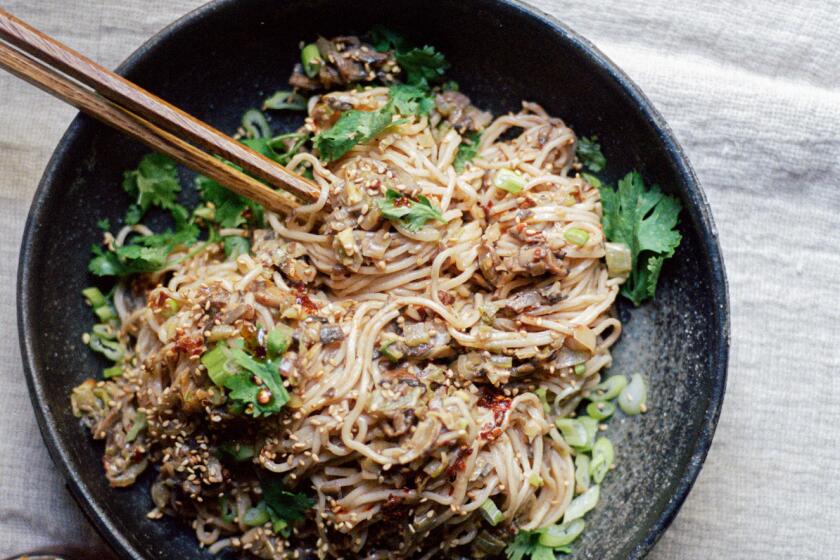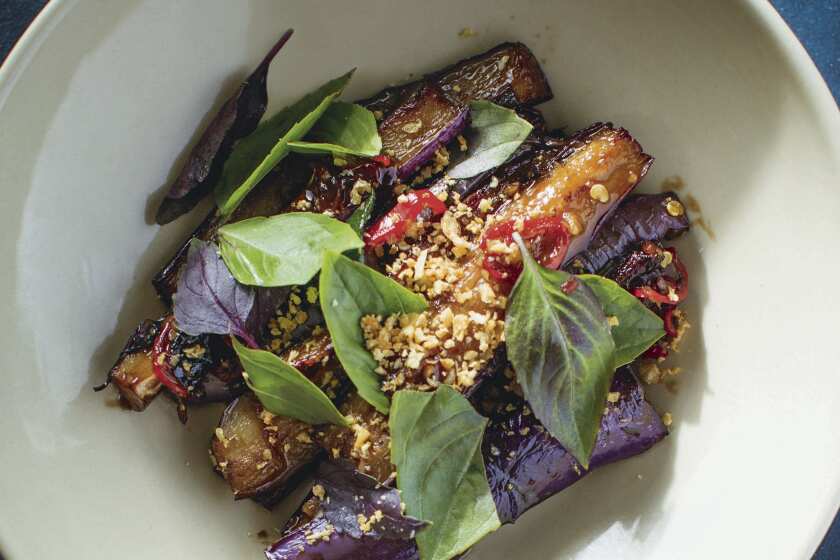Lessons from mothers and grandmothers in three new books on Chinese cooking
- Share via
In the last couple of months, three fantastic cookbooks that contextualize what it means to cook Chinese food from a second-generation perspective have been published. Taken together, they provide a snapshot of how the authors of these books detail the push-and-pull of assimilation into Western culture as children while also maintaining connections to previous generations’ cultures and traditions by learning to cook from the most important women in their lives.
In “My Shanghai: Recipes and Stories From a City on the Water,” Boston-based blogger and author Betty Liu details the cooking of Jiangsu province, or “the land of water” just north of Shanghai, with influences from the Zhejiang province to the south and the “hard-to-describe” cooking of Shanghai proper. As Liu states, “Shanghai’s culinary borders are blurred, drawing deeply from its neighbors.”
Liu learned to cook her family’s recipes for this book by watching her mother, just as her mother had done growing up in the communal kitchens of her youth with the other families she lived with. “She picked up the basics just by watching, helping out, and taking on every role in that kitchen,” Liu writes. “She learned by doing.”
Shanghai cooking, Liu states, relies heavily on the aromatic trio of fresh scallions, ginger and garlic, and those vibrant flavors are on display in many recipes in “My Shanghai,” most notably in a simple recipe for clams that calls for the trinity in three ways: as perfume while steaming the clams open, for caramelization in a quick stir-fry and, finally, as a hot garnish piled atop the clams and then sizzled with hot oil drizzled over the top.
In a different part of the world, author Hetty McKinnon grew up as second-generation Chinese Australian — her parents immigrated to Sydney from Guangdong province — and her recipes in “To Asia, With Love” capture that “third-culture cooking” in her simple, mostly vegetarian recipes that celebrate easy, quick dishes inspired not just by Chinese cooking but by the myriad influences she’s picked up through her travels and from now living in Brooklyn.
Ramen noodles are coated in an umami-rich miso and Vegemite butter sauce, potato salad gets an aromatic punch from a lively lemongrass pesto, and her vegan spin on dan dan noodles eschews the pork in favor of caramelized celery, mushrooms and leeks for an intensely savory, chilled noodle dish. “The way I cook is … a cross-pollination of ideas and techniques that are grounded in my Chinese heritage, yet greatly influenced by growing up in the Western world,” McKinnon writes.
Like Liu, McKinnon describes how learning to cook from her mother helped marry those worlds. “The more I cooked, the more connected I felt to my mother and her cultural heritage,” writes McKinnon. “Cooking alongside [her] allowed me to understand the confluence of culture, how we can be a mixture of a lot of things and still exist in harmony.”
For chef Brandon Jew, author of “Mister Jiu’s in Chinatown” (with co-author Tienlon Ho), his lessons on Chinese cooking also came via his family matriarch, his grandmother Ying Ying. She lived in San Francisco’s Richmond neighborhood and often would bring Jew along on trips to the city’s Chinatown to get ingredients. After her death, he turned to a library of Chinese cooking texts to embed himself in the rich culinary heritage of his family’s cooking and pay homage to her legacy via his cooking at Mister Jiu’s, his restaurant in the heart of San Francisco’s Chinatown.
“Mister Jiu’s connects everything that I’ve ever learned — from Ying Ying, my mentors, from all the parts of the world where I’ve lived and eaten,” Jew writes. “It is a place that celebrates all those influences, standing in the heart of Chinatown, the place where Chinese American food began.”
Indeed, the cooking in his book is filled with modern interpretations of Chinese American classics, as well as simple preparations influenced from all over China. His Taiwanese-style eggplant uses a familiar staple in a complex composition; he shows you how to re-create its ideal texture via an initial brine, a quick deep-fry and, finally, a searing stir-fry, each technique influencing the one after it to create a harmonious dish imbued with history and reverence to its makers before him.
Get the recipes:
Scallion-Ginger Clams
Celery, Mushroom and Leek Dan Dan Noodles
Taiwanese-Style Eggplant
More to Read
Eat your way across L.A.
Get our weekly Tasting Notes newsletter for reviews, news and more.
You may occasionally receive promotional content from the Los Angeles Times.











